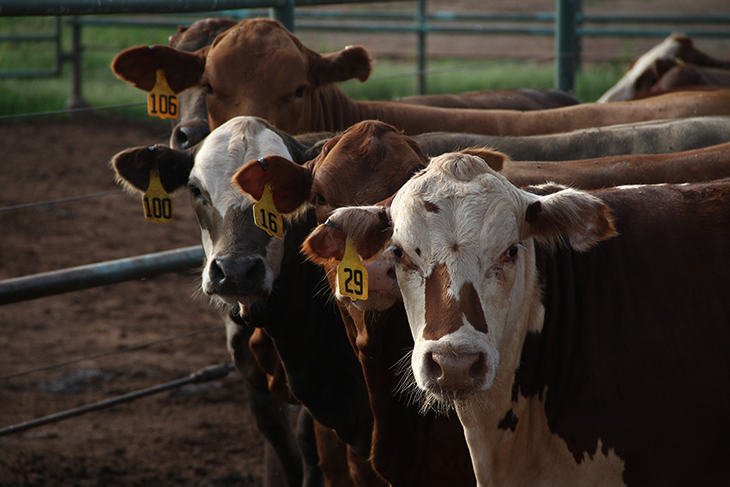
United States back to where it was after a decade of beef cow herd dynamics
Friday, June 1, 2018
The U.S. beef industry has been through many short-term and long-term changes over the past decade, despite the January 1, 2018 beef cow herd inventory of 31.723 million head being almost identical to the January 1, 2009 herd size of 31.794 million head.
“For more than half of the last decade, the U.S. beef cow herd continued a nearly uninterrupted liquidation that began in 1996 and continued until 2014,” said Derrell Peel, Oklahoma State University Cooperative Extension livestock marketing specialist.
Peel pointed out the only exception was a short-lived expansion attempt in 2005 and 2006, that added a minimal 171,000 head to the herd size before resuming liquidation in 2007.
From 2009 to 2014, the U.S. beef cow herd decreased by 2.708 million head, with the final 2 million head the result of severe drought in the Southern Plains states from 2011 through 2013. Overdue herd expansion began in 2014 with a total recovery of 2.638 million head by 2018.
Texas, the nation’s largest beef cow state, had a beef cow inventory of 5.17 million head at the beginning of the decade in 2009. By 2014, the Texas beef cow inventory was down 24.4 percent to 3.91 million head, the lowest state beef cow inventory since 1958. Since 2014, the Texas beef cow herd has added 675,000 head, recovering 54 percent of the 1.26 million head decrease from 2009 to 2014.
“Texas has recovered proportionately less than any major beef cow state since the major drought years of 2011 through 2013,” Peel said. “The current Texas inventory is 4.585 million head.”
From year to year, Oklahoma and Missouri vie to be the nation’s second-largest producer of beef cows. On January 1, 2018, Missouri had an inventory of 2.166 million head, slightly more than Oklahoma’s 2.131 million head. Over the past decade, Oklahoma ranks second in the nation with a slightly higher average inventory of 1.938 million head, compared to 1.916 million head for Missouri.
“Both states suffered drought reduced inventories from 2010 through 2013, which were more pronounced in Oklahoma where the beef cow inventory dropped by 18 percent before recovering by 26 percent between 2013 and into 2018,” Peel said.
The 2018 Oklahoma beef cow inventory is at its highest level since 1983 while Missouri is currently at a level equal to its herd size in 2006.
Nebraska comes in as America’s fourth-largest producer of beef cows. The state’s 2018 herd inventory came in at 1.910 million head, which has been pretty much the norm during the last decade.
Number five South Dakota has shown recent growth in its beef cow herd with a 2018 inventory of 1.801 million head, well above the last-decade average of 1.656 million head. The current South Dakota beef cow herd inventory is its largest since 2002.
“Our immediate neighbor to the north, Kansas, comes in at number six with a beef cow inventory of 1.501 million head, down year over year from 2017,” Peel said. “The Kansas beef cow herd has been variable over the last decade with a drought low of 1.328 million head in 2013. The decade-average beef cow herd in Kansas is 1.465 million head.”
The nation’s seventh-leading beef cow herd state is Montana, with a 2018 beef cow inventory of 1.497 million head. Montana has maintained a very stable beef cow herd size, averaging 1.481 million over the last decade.
Number eight Kentucky can likewise boast about its stability. The state’s 2018 beef cow inventory of 1.033 million head is very near its decade-average of 1.029 million head.
Not so for Florida, which typically ranked about ninth over the past decade. Recent decreases in its beef cow inventory have pushed Florida out of the Top Ten in 2018. The current Florida beef cow herd of 886,000 head is the smallest since 1964.
“North Dakota moved into the number nine spot in 2018 with a beef cow inventory of 984,500 head,” Peel said. “This is the highest North Dakota beef cow inventory since 2002.”
Iowa rounds out the Top Ten for 2018. Iowa has been a major beef cow producing state for the past decade, boasting a 2018 inventory of 970,000 head.
Other states with a notable beef cow inventory totaling more than 900,000 head include Arkansas with 924,000 and Tennessee with 910,000.
Oklahoma total cash receipts for cattle and calves typically exceeds $3.7 billion annually, according to USDA National Agricultural Statistics Service data.
The Oklahoma Cooperative Extension Service is one of two state agencies administered by OSU’s Division of Agricultural Sciences and Natural Resources, and is a key part of the university’s state and federally mandated teaching, research and Extension land-grant mission.
